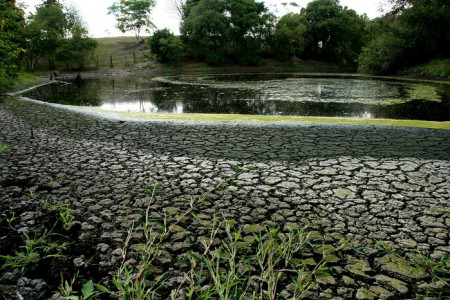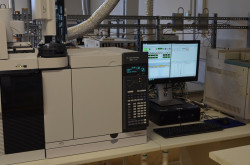New method for determination of organic pollutants in sediments after lyophilization
Mar 25, 2021
Importance of monitoring of PAH, PCB and OCP in sediments?
Organochlorine pesticides (OCPs), polychlorinated biphenyls (PCBs) and polycyclic aromatic hydrocarbons (PAHs) are organic substances that occur as chemical individuals or mixtures with toxic properties, persist and bioaccumulate in the environment, and are transported hundreds or even thousands of kilometers from their source.
These substances are proven to have significant harmful effects on human health and adverse effects on the environment.
The first two groups (OCP and PCB) belong amongst persistent organic pollutants (POPs) and are included in the list of priority pollutants of the Stockholm Convention. Many PAHs, the best known of which is benzo [a] pyrene, show genotoxic and mutagenic properties.
Distribution of these contaminants in various parts of the environment is influenced by many factors and, due to their occurrence in the atmosphere, aquatic and terrestrial ecosystems, they are considered ubiquitous environmental contaminants. Their affinity for the aquatic environment is minimal, but they are readily sorbed to solid particles as it ash, dust, soil or sediment. Due to the fact that accumulation of these substances in sediments may last for many years, sediments are considered to be an important reservoir of contaminants and material often monitored for environmental pollution.
Preparation of sediments for determination of PAH, PCB and OCP by lyophilization
How to process a sediment sample that contains the majority of water, which is in this case is an undesirable component? It is necessary to remove it effectively and gently before analysis in such a way that there is no loss of target analytes or major change in the nature of the sample.
Thus, lyophilization is preferably used, a process of gentle drying of samples in the frozen state, without the need to use heat. The use of vacuum sublimation of water (respectively ice) allows to preserve the original structure of the dried sample. Freeze-drying is currently used across technological sectors, the most well-known of which is fruit processing in the food industry. The lyophilization process consists of three phases - freezing, primary and secondary drying.

In a first phase, the lyophilized sample is totally frozen so no liquid can exist. The drying phase involves the sublimation of ice from the frozen product using a vacuum, i.e. the transition from a solid state directly to a gaseous one. The water vapor is then frozen on a condenser. The capacitor is maintained at -55 ° C or lower. The lyophilization time depends on the amount of sample and its water content. As result a perfectly dried "standardized" sample is obtained, which can be already well processed further in subsequent extraction. When lyophilizing the sample, the risk of loss of volatile analytes is minimized and only about 10 g of final lyophilisate is needed for all PAH, PCB and OCP analysis.
Determination of PAH, PCB and OCP in lyophilized sediments
After lyophilization, the sample free of all water is ready for extraction of organic analytes. For substances that have been sorbed on the material for several decades, a sufficiently efficient, robust and fast type of extraction must be chosen - ideally with minimal solvent consumption to minimize the impact on the environment. The question is whether normal extraction in an ultrasonic bath or mechanical extraction by shaking will be sufficient, or is it appropriate to choose several hours of extraction through Soxhlet? ALS went even further and chose modern equipment for the extraction of environmental samples using microwave-assisted extraction. A small amount of solvent is sufficient for such extraction and efficient migration of target substances from the sample directly into the solvent occurs. Unlike Soxhlet extraction, the extraction time is reduced from hours to tens of minutes while maintaining high extraction efficiency. Thanks to the optimized microwave process, up to 24 samples can be extracted in our device in 60 minutes.

The obtained extract is then subjected to target analysis on a modern Agilent system - gas chromatograph connected to a tandem mass detector. This system ensures selectivity at the level of micrograms per kilogram of lyophilized sample. The result is an analytical record in which any influence of the matrix is reduced due to the specific setting characteristic of each monitored substance.
By using state-of-the-art technology and a suitable combination of lyophilization, microwave extraction and gas chromatography with a tandem mass detector, ALS has obtained a reliable, efficient and fast procedure for monitoring persistent organic pollutants in a diverse spectrum of sediments at the level of ultratrace concentrations. The method is fully validated and accredited by the Czech Accreditation body.
Technical characteristics of PAH, PCB and OCP methods in lyophilized sediment on GC-MS/MS
• Required amount of sample after lyophilization 10g
|
Parameter |
Limit of quantification (mg/kg DW)) |
Parameter |
Limit of quantification (mg/kg DW) |
Parameter |
Limit of quantification (mg/kg DW) |
|
PAH (16 compounds) |
PCB (7 congeners) |
OCP (22 compounds, continued) |
|||
|
naftalene |
0.01 |
PCB 52 |
0.0001 |
Hexachlorocyclohexane Beta |
0.0001 |
|
acenaftylene |
0.01 |
PCB 28 |
0.0001 |
Hexachlorocyclohexane Gamma |
0.0001 |
|
acenaftene |
0.01 |
PCB 180 |
0.0001 |
alfa-endosulfan |
0.01 |
|
fluorene |
0.01 |
PCB 153 |
0.0001 |
heptachlor |
0.01 |
|
fenanthrene |
0.01 |
PCB 138 |
0.0001 |
heptachlorepoxid-cis |
0.01 |
|
anthracene |
0.01 |
PCB 118 |
0.0001 |
heptachlorepoxid-trans |
0.01 |
|
fluoranthene |
0.01 |
PCB 101 |
0.0001 |
hexachlorethane |
0.01 |
|
pyrene |
0.01 |
sum of 7 PCB |
0.0007 |
telodrin |
0.01 |
|
benzo(a)anthracene |
0.01 |
OCP (22 compounds |
aldrin |
0.01 |
|
|
chrysene |
0.01 |
hexachlorbenzene (HCB) |
0.0001 |
dieldrin |
0.01 |
|
benzo(b)fluoranthene |
0.01 |
pentachlorbenzene |
0.01 |
endrin |
0.01 |
|
benzo(k)fluoranthene |
0.01 |
4,4'-DDE |
0.0001 |
2,4-DDT |
0.0001 |
|
benzo(a)pyrene |
0.01 |
hexachlorbutadiene |
0.01 |
isodrin |
0.01 |
|
Indeno(1 2 3-cd)pyrene |
0.01 |
2,4-DDE |
0.0001 |
2,4-DDD |
0.0001 |
|
dibenzo(a,h)anthracene |
0.01 |
4,4'-DDD |
0.0001 |
||
|
benzo(g,h,i)perylene |
0.01 |
4,4'-DDT |
0.0001 |
||
|
sum of 16 PAU |
0.16 |
HCH alfa |
0.0001 |
||

